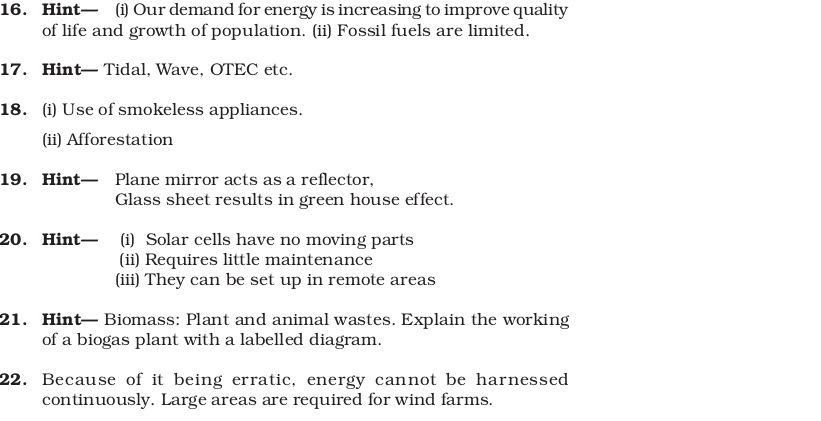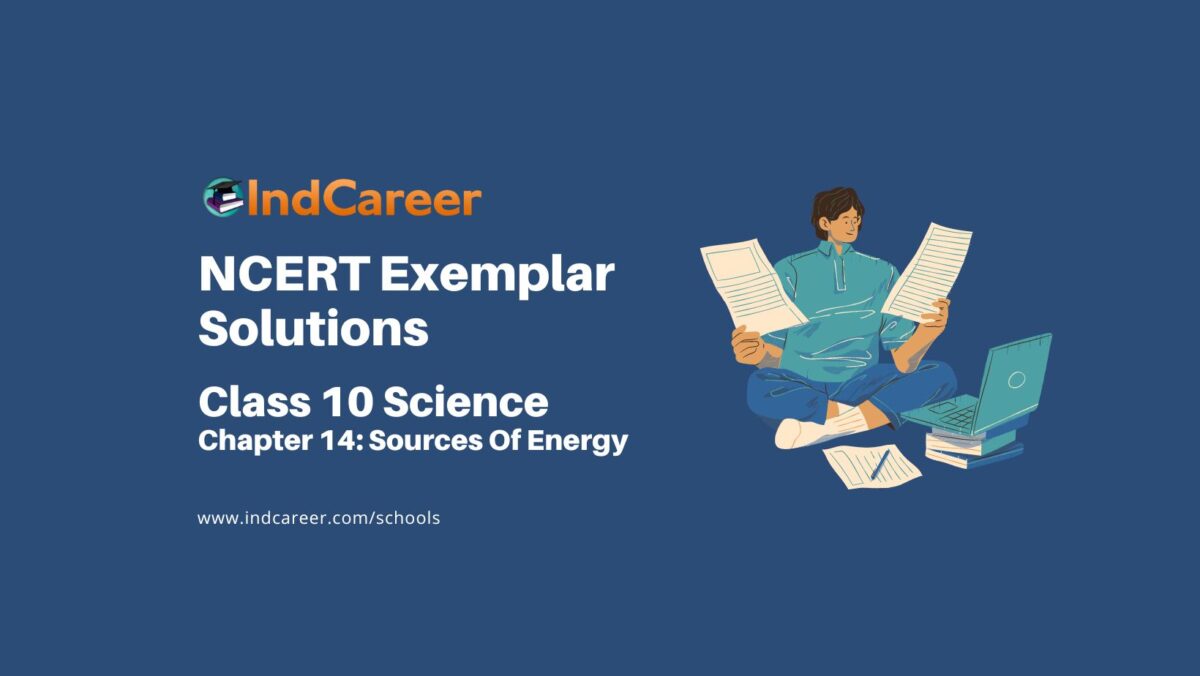NCERT Exemplar Class 10 Science Chapter 14: Sources Of Energy. NCERT Exemplar Solutions for Class 10 Science Chapter 14 Sources Of Energy prepare students for their Class 10 exams thoroughly.
Science problems and solutions for the Class 10 pdf are provided here which are similar to the questions being asked in the previous year’s board.
Contents
NCERT Exemplar Class 10 Science Chapter 14: Sources Of Energy
Class 10 : Science Chapter 14 solutions. Complete Class 10 Science Chapter 14 Notes.
Multiple Choice Questions
- Which of the following is a non-renewable source of energy?
(a) Wood
(b) Sun
(c) Fossil fuels
(d) Wind - Acid rain happens because
(a) sun leads to heating of upper layer of atmosphere
(b) burning of fossil fuels release oxides of carbon, nitrogen and sulphur in the atmosphere
(c) electrical charges are produced due to friction amongst clouds
(d) earth atmosphere contains acids - Fuel used in thermal power plants is
(a) water
(b) uranium
(c) biomass
(d) fossil fuels - In a hydro power plant
(a) Potential energy possessed by stored water is converted into electricity
(b) Kinetic energy possessed by stored water is converted into potential energy
(c) Electricity is extracted from water
(d) Water is converted into steam to produce electricity - Which is the ultimate source of energy?
(a) Water
(b) Sun
(c) Uranium
(d) Fossil fuels - Which one of the following forms of energy leads to least environmental pollution in the process of its harnessing and utilisation?
(a) Nuclear energy
(b) Thermal energy
(c) Solar energy
(d) Geothermal energy - Ocean thermal energy is due to
(a) energy stored by waves in the ocean
(b) temperature difference at different levels in the ocean
(c) pressure difference at different levels in the ocean
(d) tides arising out in the ocean - The major problem in harnessing nuclear energy is how to
(a) split nuclei?
(b) sustain the reaction?
(c) dispose off spent fuel safely?
(d) convert nuclear energy into electrical energy? - Which part of the solar cooker is responsible for green house effect?
(a) Coating with black colour inside the box
(b) Mirror
(c) Glass sheet
(d) Outer cover of the solar cooker - The main constituent of biogas is
(a) methane
(b) carbon dioxide
(c) hydrogen
(d) hydrogen sulphide - The power generated in a windmill
(a) is more in rainy season since damp air would mean more air mass hitting the blades
(b) depends on the height of the tower
(c) depends on wind velocity
(d) can be increased by planting tall trees close to the tower - Choose the correct statement
(a) Sun can be taken as an inexhaustible source of energy
(b) There is infinite storage of fossil fuel inside the earth
(c) Hydro and wind energy plants are non polluting sources of energy
(d) Waste from a nuclear power plant can be easily disposed off - In a hydroelectric power plant more electrical power can be generated if water falls from a greater height because
(a) its temperature increases
(b) larger amount of potential energy is converted into kinetic energy
(c) the electricity content of water increases with height
(d) more water molecules dissociate into ions - Choose the incorrect statement regarding wind power
(a) It is expected to harness wind power to minimum in open space
(b) The potential energy content of wind blowing at high altitudes is the source of wind power
(c) Wind hitting at the blades of a windmill causes them to rotate. The rotation thus achieved can be
utilised further
(d) One possible method of utilising the energy of rotational motion of the blades of a windmill is to run the turbine of an electric generator - Choose the incorrect statement
(a) We are encouraged to plant more trees so as to ensure clean environment and also provide bio-mass
fuel
(b) Gobar-gas is produced when crops, vegetable wastes etc., ecompose in the absence of oxygen
(c) The main ingredient of bio-gas is ethane and it gives a lot of smoke and also produces a lot of residual
ash
(d) Bio-mass is a renewable source of energy
Short Answer Type Questions
- Why is there a need to harness non-conventional sources of energy? Give two main reasons.
- Write two different ways of harnessing energy from ocean.
- What steps would you suggest to minimise environmental pollution caused by burning of fossil fuels?
- What is the role of a plane mirror and a glass sheet in a solar cooker?
- Mention three advantages of a solar cell?
- What is biomass? What can be done to obtain bio-energy using biomass?
- What are the limitations in obtaining energy from wind?
Long Answer Type Questions
- Which is the process used to harness nuclear energy these days? Explain it briefly.
- How can solar energy be harnessed? Mention any two limitations in using solar energy. How are these limitations overcome?
- Make a list of conventional and non-conventional sources of energy. Give a brief description of harnessing one nonconventional source of energy.
- Why is there a need for harnessing non-conventional sources of energy? How can energy be harnessed from the sea in different ways?
- What are the environmental consequences of using fossil fuels? Suggest the steps to minimise the pollution caused by various sources of energy including non-conventional sources of energy.
- Energy from various sources is considered to have been derived from the sun. Do you agree? Justify your answer.
- What is biomass? Explain the principle and working of a biogas plant using a labelled schematic diagram.
Answers
Multiple Choice Questions
Short Answer Questions
Long Answer Questions

